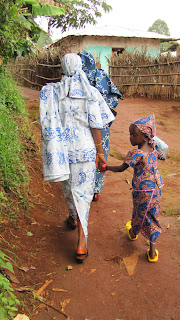A Visit to Sabga to attend the beginning of the celebration of Ramadan.
By Mimi’s invitation, we decided to attend Ramadan, the celebration of Abraham equal to our Christmas in Moslem tradition. John Baptist from IDF accompanied us and we were driven by Julius, IDF’s driver. Stephen rented his car to us for the day. The village is about 30 minutes from Bamenda in distance but traditionally is still adhering to its ancient tribal ways.
We were greeted by Mimi who quickly took us to her home. Mimi’s family garden has maise, beans
We were warmly greeted by her mother, grandmother and great grandmother as well as sisters and relatives. This is a real gathering time for families. Mother was busy in the kitchen. We were told that we must make our way to the central village area as the festivities were about to start. The parade was already making its way along the village road to the common area.
Soon the chief arrived to the sound of the drums and the trumpet made from a cow’s horn.
Inside the Palace area there is a burial shrine, a thatch roofed round building and the Chief’s Palace.
Seeing that everyone had removed their shoes, we removed our shoes at the door only to be told once seated that women were not to remove their shoes. Afraid to move, Lydia’s shoes remained outside for the duration of the visit. This shoe taken off at the door is intriguing, locally made from cow hide no doubt.
We had to duck to go through the door. The inside had only the natural lighting from the door so was quite dark. Almost immediately, food began arriving in pots. A beef in spicy liquid, cassava and warm Sprite and Fanta brought in a pail. Mimi, the chief’s grand -daughter, served us. The chief and elders watched as we ate.
Guests books are very important. The chief invited us to sign the guest book. When Lydia took out the only pen we had with us, he thanked us very much. When she took out a little day timer, he thanked us and asked for the 2012 version. He requested that we send him prints of the pictures taken from Canada. He said he would like to visit us when he comes to Canada. 5
After the visit, we were again accompanied by the band back to the common area. We were then free to visit Mimi and her family. Four generations of women live in one house. Below you will see Mimi, Mimi’s Mother, Mimi’s grandmother and Mimi’s great grandmother. Note the treadle sewing machine behind Mimi’s grandmother. It was on this machine that Mimi’s mother made Mimi’s new dress, especially for Ramadam.
Of course they had a great meal of bitter leaf, cassava (fufu) and boiled beef in a delicious sauce ready for us all (driver, Jean Baptist, Allan and Lydia). But we had just eaten. Never mind, eat again.
Outside, bitter leaf drying and two grandmothers drawing intestine through water to prepare it for sausage making.
Mimi went with us in the car, travelling up the path to the grazier areas.
Twenty minutes from Bamenda. Another world.
A sad note. At the end of the visit, Mimi invited Lydia to visit her sick uncle in bed in the last room of the house. He was sitting up, eating but his body is so wasted. His shoulders mere knobs. His arms bones. He was a text book picture of someone dying of HIV AIDS. Mimi said TB. The internet says that TB is very common in this area of the Cameroon and often is a later problem arising from an immune system compromised by HIV AIDS. Oussematou says that this man can be treated with drugs and that many have come back much worse than he. He has been two months in hospital and four months sick at home. Oussematou asked what his hospital book says. Lydia did not go past the threshold but just having finished the Nutrition workshop where we practiced interviewing HIV AIDS patients, the questions came easily. Eating, yes. Skin covered with tiny bumps all over and itchy. No energy. Barely able to walk, only with assistance. Drugs? Diagnosis? Lydia was not aware of the hospital book and did not receive a clear answer about whether this man is taking drugs that were prescribed. Oussematou says that many have come back from a state worse than this and with proper drugs, good nutrition and care, can lead a healthy, productive life.
Lydia Sorflaten











No comments:
Post a Comment